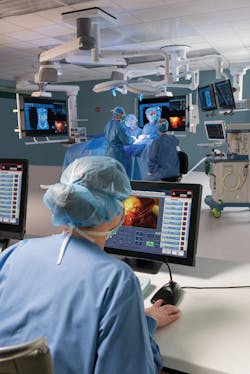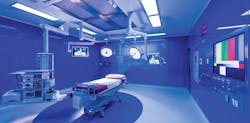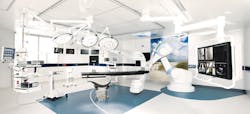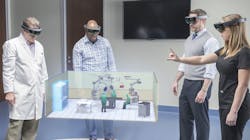Facilities that succeed in attracting top surgical staff and top patient satisfaction scores know the value of a top-shelf surgical suite. Having a state-of-the-art operating room isn’t just another item on a surgeon’s wish-list anymore. It’s become an essential asset that providers need in order to support current and future surgical procedures, complex instrumentation, and workflow demands.
Getting an OR renovation project off the ground may seem like a colossal undertaking but with sharp, strategic planning, consistent collaboration with the right stakeholders, and savvy vendor and product selection, the process can go smoothly. Healthcare Purchasing News asked those in the know what facilities need to think about before, during, and after a surgical suite renovation.
HPN: What do various specialty surgeons and OR staff typically want inside their surgical suites today and why?
Pamela Rockow, Director of Marketing, Surgical Workflows, Getinge: Regardless of the surgical discipline, members of the surgical team expect to have at their disposal all of the tools they need to meet the heightened expectation of achieving positive patient outcomes. At the same time, they are acutely aware of the financial impact of effective surgical workflows and OR scheduling. Up to 65 percent of an institution’s revenue is generated in the OR.
Consequently, surgeons, in particular, want such amenities as the latest advancements in surgical lighting that minimize the need for manual light head adjustments during surgery while providing consistent illumination to help them distinguish subtle differences in tissue color.
As far as tables are concerned, busy ORs require a highly versatile design that enables fast OR turnover while minimizing the need to store underutilized specialty tables. Flexible table positioning is the key to ensure optimal safety and comfort for both the surgeon and patient. Any new or renovated OR moving forward should also accommodate OR integration and image-guided surgeries, because the “OR of the future” has already become the Hybrid OR of today.
Laura Holly, Director, Marketing and Product Management, Image Stream Medical: Identifying each surgeon’s clinical, technical, and procedural needs for the various procedure rooms is a key component to a successful surgical renovation. An imaging-centric hybrid OR has very different requirements than an otolaryngology clinic and will need to support the hospital’s own clinical workflow, not one that is dictated by a vendor. The committee will ask the clinical team to map the clinical disciplines involved, the types of procedures performed, the number of procedures performed daily, and the required clinical workflow for each discipline. An important question specific to the room, is to understand if it will be used solely for a certain procedure type or if will require a high degree of flexibility to accommodate multiple procedures.
Surgeons seek simplicity so he or she can focus on delivering high-quality patient care. This may come from making it easy to hear their personal playlist in the room as they prepare, or the ability to review the procedure images with patient’s families after a successful surgery. This is the same motivation for other medical staffs like biomed, IT, and even equipment planners and architects.
For this reason, it is critical that the hospital shares the workflow for each procedure space and where the technology needs to integrate with existing workflows. Focusing on a hospital’s internal workflow provides the opportunity to overcome obstacles that make surgery cumbersome.
Aaron Young, Marketing Manager, Stryker: The specific requirements vary widely based on surgical specialty and the types of cases that will be performed in these operating rooms. In general, surgeons and staff want rooms that are well-designed and which optimize intra and inter-operative workflow and which enable them to focus on their patients. In addition to the common equipment used for routine surgical cases, the room must also be able to accommodate specialized equipment that may be transported into the room for more specialized procedures. It’s expected that this equipment can be brought in before or during a case and easily connected without disrupting the other equipment and systems in the room.
Jake Isley, Senior Product Manager, Olympus of Americas Corporation: Surgeons want technologies that enable informed decision-making and drive efficiencies. Forward-thinking staffs demand more than just ‘surgical equipment,’ and are seeking ways to collaborate and connect in real time.
Noreen Cioffi, Marketing Manager, Architectural Systems and Healthcare Design, Draeger: We see a need for both flexible surgical suite design and a need for targeted designs for dedicated procedures, such as minimally invasive.
Hybrid OR’s are also a fast-growing trend; these complex OR’s bring quick point-of-care assessment for the surgeons and greatly improve overall patient care. The complexity of equipment needed in these Hybrid OR’s requires a very precise and coordinated design. Certain surgical disciplines have very specific needs, and the operating room suite must incorporate physician preferences in terms of spatial requirements. For example, a right shoulder procedure will require very specific spatial configuration. Cardiac operating rooms require careful mapping of where perfusion will be positioned and potential vein harvesting at the end of the operating room table. 3D renderings of rooms which map specific dimensions of all equipment in the room assist in confirming that the surgeon’s needs are achieved.
Gulam Khan, Senior Vice President, Procedural Solutions, STERIS Corporation: While early integrated suites focused mainly on routing video, modern integrated suites offer a broader reach by seamlessly connecting the surgical staff with information, teams, and processes located outside the OR. For example, with STERIS integration solutions, clinicians within the OR can consult with remote specialists in real time, or pull real-time information from electronic medical records. The safety and satisfaction of staff and patients remain top-of-mind, and the methods for meeting those needs continue to improve.
With the continual rise in minimally invasive and robotic surgeries, the surgical suite is challenged to accommodate new imaging modalities. STERIS offers an in-room display that pulls real-time critical patient data forward. SAFE (situational awareness for everyone) replaces white boards, paper checklists and allows the surgical team to employ the most robust dynamic universal protocol. Surgeon led procedure verification can now be widely implemented with this dynamic board that is configurable to meet each facility’s policies.
Can a facility’s existing equipment/technologies be blended into the new OR infrastructure? What can and cannot be integrated and why?
Holly: Yes, in many cases however, it will require a vendor-neutral solution to integrate all of the equipment both new and old. Hospitals look for ways to reduce cost and many find if it avoids a single vendor solution it maximizes both clinical and financial value.
Patient outcomes are the priority and each hospital has its own preferences and reasons for the equipment it purchases or chooses to keep as a legacy solution. To accomplish this, it needs an integration solution to integrate with a variety of procedure room equipment in multiple procedure rooms across the entire enterprise. Ideally, the integration can provide a foundational technology needed for not only today, but for tomorrow in however the hospital’s services evolve.
In addition to the medical equipment, booms, and lights in the actual procedure room, hospitals require seamless interoperability with electronic health record (EHR) systems, picture archiving and communication systems (PACS) and vendor-neutral archives (VNA). The goal for hospitals is beyond just integration, it is for automation that improves patient care, ranging from patient safety and room distractions to increasing the quality of surgical imagery and team communications.
Isley: In regards to imaging and integration, it is indeed possible to incorporate existing equipment into a given design, and better plan for future renovations. For example, customers should research a vendor’s ability to accommodate multiple video platforms (e.g., 2k, 4k, 3D) into the surgical suite, even if it means using other vendor’s equipment. This customer-centric approach gives the planning committee more flexibility rather than being locked into a single vendor, or having to purchase all product categories at the same time.
How has OR technology improved in recent years? Does it offer something it didn’t five to 10 years ago?
Rockow: To be sure, people were surgically treated with much success five to 10 years ago because the foundation of current surgical lights, booms and table technology had already been established. With notable exceptions (hybrid OR technology for image-guided procedures and OR integration platforms), enhancements to surgical workflows have been evolutionary in design.
Perhaps the greatest contribution these relatively new and emerging technologies offer today that wasn’t available a decade ago is a track record of evidence-based performance that significantly has reduced the perceived risk of adoption.
Daniel Walters, Surgery Customer Solutions Manager, GE Healthcare: Technology has evolved and improved drastically in recent years. Regarding surgical imaging capabilities in the OR, there has been advancement in CMOS flat panel detectors in mobile C-arms. GE Healthcare introduced several new surgical C-arm imaging systems — such as the OEC Elite CFD mobile C-arm and the OEC Elite MiniView mini C-arm — to bring enhanced visualization of detail during surgical imaging through CMOS flat panel detectors to our customers, as well as larger monitor displays and ergonomic enhancements.
In addition to surgical imaging advances, there is generally more equipment in an OR for advanced or complex surgical procedures. For ergonomic enhancements, the new OEC Elite CFD C-arm provides enhanced maneuverability and reach around the patient table and an articulating monitor display arm for ease in visibility and reach. For extremity procedures, the OEC Elite MiniView mini C-arm offers enhanced ergonomics with SmartLock, a one-button push to lock the C-arm in place, rather than requiring surgeons to turn multiple locks. To address tight surgical spaces, GE Healthcare offers an integrated system with an OEC 9900 surgical C-arm and GE Venue ultrasound system, combining two systems into one.
As for OR tables, they have evolved to become more flexible. Tables can now be outfitted for a greater variety of procedures. Within the OR, there are frequently additional monitors to display clinical information. As display technology advances, so has the availability of higher resolution and larger LCD displays.
Cioffi: Technology relating to OR booms have improved more specifically with advancements in lighting and accessories that are required in various surgical procedures. Adapting to the complex ancillary equipment being used in the OR is essential for the booms overall flexibility and use. We are seeing more cable management solutions as well.
What do planning committees need to be aware of when it comes to booms?
Rockow: As the complexity and diversity of procedures increase — especially in the Hybrid OR — the deployment of a flexible ceiling supply unit has become virtually mandatory to facilitate provider-patient interactions and enhance safety, especially wherever space is at a premium.
Cioffi: Research conducted on OR design has found the location of booms to be a major disruptor in surgeries. Nursing staff often spend crucial time maneuvering or changing positions of key equipment due to poor boom layouts. Planning committees need to ensure the feedback and participation of the clinical team early in the planning phase. It is vital that planning committees focus on the optimal use of the OR and ensure that all considerations have been outlined.
Map out the spatial requirements for each surgical discipline; each procedure may require different equipment and configurations. 3D modeling and mock-up simulations are also great tools to help plan this space.
Young: Gathering feedback and recommendations from all stakeholders is a daunting task and critical input is not always incorporated into the final room design. For instance, the mounting locations of equipment booms are an important consideration. During a recent project, we hosted a design session to confirm that the final room drawings were correct. We discovered that the boom placement identified through previous design sessions would not allow for optimal workflow in the new room. In real time, we were able to move the boom mounting location and show the nursing staff what the room would look like, in life-size scale, using the HoloLens. After confirming the new placement would provide better room coverage and reach, the room design drawings were finalized.
Speaking of committees, who should come to the table when planning a renovation?
Traci Lavigne-Milnes, RN, BSN, Clinical Manager, Surgical Services, Lawrence General Hospital: As many stakeholders as possible. We asked vascular surgeons, urological surgeons, radiology interventionalists, anesthesiologists, as well as IR techs, OR techs, OR RN’s to assist us, the management and senior management with the decisions for the Hybrid room. For the other OR rooms, we also included orthopedic and general surgeons, no one could attend every meeting, but we went out of our way to have frequent discussions and reviews with the various stakeholders. It is difficult to get everyone on board with change, but when they feel they have a part to play in the decision making, champions emerge, and they can assist in.
Surgeons want things easier for them. Anything that can assist them so they use their time wisely and most efficiently is a bonus to them. We provided them easy viewing of the imaging systems, easy chart maintenance by putting computers for them in every OR. They want the ability to have their patient positioned correctly and easily, especially important with Orthopedics. They also love to have their music choices at their fingertips.
Rockow: Highly successful renovation/new construction projects have one thing in common. They all incorporate the requirements and preferences of the many stakeholder groups who have a vested interest in making sure the overall plan meets their individual needs. For this reason, the planning committee should include the following representatives:
Architectural firm – Without a seat at this particular table, there is no way for the architect to design an OR that reflects the needs of each constituent group. There is no such as a generic OR.
Facilities management – The new/renovated OR needs to work within the confines and limitations of the existing or expanding structure. From a construction and logistical point of view, facilities management has a thorough understanding of the big picture.
OR manager – Effective OR design must enhance the surgical workflow, and the OR manager serves as the orchestra leader who knows what it takes to keep everyone performing together in harmony.
Hospital administration – If project costs were not an issue, their presence may not be required. But costs are always an issue. The bucks start here. And the buck stops here.
Director of surgery – Since surgeons are relied on to prepare the meal, they should have the ability to help select the ingredients.
Biomed engineer – Soon after the OR is commissioned, service and maintenance becomes an ongoing issue for years to come. Based on its experience with multiple vendors, the Biomed team can help steer capital equipment selection to ensure potential problems are not baked into the original recipe.
Purchasing – The more that Purchasing understands project objectives and the inevitable compromises and give-and-take that need to be made among the various stakeholder groups, the better they can write explicit RFPs and manage vendor selection.
During the planning process, the selection of an appropriate project manager is key to ensuring that timelines are being followed; individuals are being held accountable for providing input or completing their assignments on a timely basis; and that budgetary objectives are being met.
Walters: Building a smart, hybrid surgical suite requires a cross functional team to ensure the suite is properly and effectively built. The team should include:
A general contractor for structural, electrical, HVAC and other building considerations
facilities management, as they will presumably be working with the general contractor and maintain the OR after it is completed
Surgeons and OR managers to ensure necessary features and an efficient workflow are incorporated
VP of nursing to voice nursing staff needs in the room and VP of OR to voice room needs by specialty
The facility’s chief financial officer and the purchasing department to approve and negotiate the cost of the room
The IT department to ensure PACS connectivity and other communications needs.
Before embarking on a surgical suite renovation, GE Healthcare recommends providers to include the interested parties as early as possible in the planning process. Each user of the room – from surgeon to rad tech to IT – has unique challenges and needs for OR efficiency. When planning involves the many stakeholders, a more fluid OR experience can be achieved.
Isley: A successful planning and design committee will be inclusive and incorporate feedback from multiple individuals as part of an iterative process. In this way the planning team will avoid some of the more common pitfalls of conventional design approach, which may exclude key stakeholders from the beginning. While it may be difficult to accommodate an increasing number of individual inputs, it is common practice to include clinical, C-Suite, and vendor decision makers at the outset and throughout. One of the roles which is becoming increasingly more important, and commanding more influence, is that of Information Technology.
For this reason, Olympus is placing emphasis on jointly developing a thorough Information and Communication Technology (ICT) strategy with its customers as it relates to the Operating Room. Traditional OR integration merely connects devices. We want to connect people.
Young: Effective committees are small, cross-functional teams that meet regularly to collaborate and come to consensus on a myriad of planning and design decisions. In addition to external consultants such as architects and equipment planners, the hospital team is typically composed of representatives from biomed or facilities, the surgical staff, clinical nursing, purchasing and administration.
Facilities should spend as much time thinking about placement and maneuverability of equipment within the room as you do on the actual evaluation of individual products. It’s important to remember that even the best surgical light is rendered inadequate if it can’t be positioned where the surgical staff needs it easily and predictably.
Forest: From the hospital side, projects that are efficient and produce the desired outcomes, usually have one representative chosen to speak on behalf of the end users (primary clinical contact) to the vendors. Typically, the Director of Bio-med or the head of the hospital’s IT department will be involved to make sure that the planning committee has a solid grasp on all the different types of technology that will be required for each space. In addition, an IT security person will be participating to do security vetting. Having C-Suite sponsorship of the project ensures that the planning committee has a good understanding of the requirements of multiple steps, and the true scope of the project.
The hospital will also hire contractors to complete the build-out of the room along with electricians for building out the infrastructure. It is important during the build-out that the General Contractor and electricians are knowledgeable of what is needed for infrastructure, forecast potential challenges and communicate any changes needed during the construction -and how it affects the infrastructure.
Depending on the type of space, there will be a variety of vendors that could be involved. It is imperative that a meeting with all vendors is completed early in the project planning. Most of the time vendors will be comprised of 1. Integration Vendor 2. Booms and Lights provider and 3. Medical equipment planner and/or representatives from the medical equipment provider.
Khan: End users provide invaluable first-hand clinical perspective, and should be included in even the earliest planning discussions to establish clinical needs. Clinicians will indicate the aspects of workflow, communication and visualization they want to see improved. Biomedical engineering and IT departments will identify connectivity requirements for current and planned information systems, imaging technologies, and network architectures.
Once clinical needs are identified, form can follow function. Architects will plan for optimal equipment rack placement, whether under a desk, in the wall, or outside the OR, for example, to maximize floor space and room flexibility.
Leverage the expertise of your preferred integration provider throughout the planning process, even before the project goes to bid. Acting in a consultative capacity, the integration provider can work with the institution to identify how integration can solve their unique challenges.
Expert integration providers can bring past successes and challenges to help guide the hospital toward smart OR’s that meet their needs. Integration providers that bring clinical expertise as well as planning and designing expertise will be invaluable as the facility moves forward.
What are some of the most common pitfalls when renovating and how can your company help facilities avoid them?
Holly: We have a team of skilled installation experts that help to ensure minimal downtime and disruption, while delivering rooms that are installed and configured to the exact specifications of our client’s clinical users. For example, specifying the location of room displays and imaging source wall plates is painless to change early on, but once cable is pulled and walls are built, it becomes an expensive and difficult change order.
The earlier we understand how integration can best support the hospital’s goals, the more value we can add to help clarify the client’s specific needs and reduce project risk. This is more than a check-the-box questionnaire; it is a process of collaboration with clinicians to understand their workflows, and designing room configurations to complement these workflows. It may also entail developing site-specific room drawings, assisting with initial site and IT infrastructure verification, like server requirements, network configuration, remote support access, and EHR integration details.
Kahn: STERIS mock rooms create a convenient and immersive setting for evaluating STERIS technologies first-hand, feeling their ease of use and seeing the clarity of the surgical video. Customers have found mock rooms invaluable for visualizing the minimal footprint of STERIS systems, and creating a powerful side-by-side comparison to the outdated systems they currently use. In addition to mock rooms, STERIS uses a virtual reality OR simulator to show the surgeon, anesthesiologist, and other surgical personnel’s vantage points in a case-specific setting.
What would you want supply chain and purchasing teams to know about your product line? Why is it a good investment?
Rockow: Hospital administrators and architectural planners often struggle to create the ideal footprint for the OR, and other heavily equipped areas knowing the likelihood that emerging technologies and patient care strategies could render the initial floor plan inadequate in meeting anticipated, but yet unknown, needs in the future.
Unfortunately, permanent construction is difficult and costly to modify at a later date and could result in a lengthy period of downtime when room utilization is on the rise. That’s why Getinge created the VARIOP System of walls, ceiling, doors and windows that can be disassembled and re-assembled at a fraction of the time and cost with minimal downtime to accommodate future expansion and new technologies.
Hospital surroundings are rapidly changing to reflect the increasing emphasis on environmental aesthetics that is widely acknowledged to improve job satisfaction and morale in the workplace and a sense of well-being among patients.
VARIOP’s individually printed wall elements create a comforting ambience in a virtually unlimited selection of custom motifs and colors. In addition, ceiling-high glass doors and other glass elements allow additional light to enter the room while establishing the visual perception of spaciousness within smaller confines.
VARIOP’s modular design incorporates a comprehensive selection of made-for-each-other wall panels, doors, glass elements ventilation units and an integrated ceiling system (including room lighting) supported by a solid substructure. Individual elements are easy to assemble and disassemble without special tools, reducing installation time, debris, dust and noise.
VARIOP’s innovative suspended ceiling system also provides fast access to air-conditioning, medical gases and electrical connections for maintenance and repair. In addition, ceiling components are easy to disassemble, facilitating changes to the ceiling’s integrated air-supply unit, operating lights, ceiling service units and room lighting when expanding or modifying room configurations.
In addition, VARIOP’s large, smooth surfaces are easy to clean and disinfect to help speed room turnaround. Powder-coated finishes can be specified to inactivate or inhibit bacterial growth.
Walters: With years of clinical and service specialists supporting customers, GE Healthcare brings clinical expertise in planning OR suites with an equipment offering to serve a broad range of clinical specialties. GE Healthcare has a new line of surgical C-arms, OEC Elite, which feature advanced flat-panel detectors with choice and clinical versatility. From dedicated surgical suites to general surgery with broad range of patient case mix, GE Healthcare’s OEC Elite C-arms are a smart choice for surgical teams. GE Healthcare also offers tables, monitors, lights and pendants that are modular and expandable with configuration flexibility — perfect for meeting healthcare providers’ dynamic needs. This breadth enables a customer to have a more streamlined planning process and single source purchasing of primary surgical equipment.
Young: Earlier this year, we introduced the ByDesign Experience powered by HoloLens. This cutting-edge technology allows us to virtually design an operating room to exact specifications with our proprietary software. Our customers then wear a Microsoft HoloLens headset which brings their future OR vision to life right before their eyes.
We’ve invested in this technology because we believe that optimal operating room design is critically important. It is included as part of our overall consultative design process and there is no charge for this capability. Incorporating ByDesign and HoloLens into the design process will help to shorten timelines, reduce costs, and increase predictability of the project as a whole. Clinicians provide feedback on the room design and layout which is then provided to equipment planners and architects immediately, shortening the time it takes to make meaningful, clinically-relevant changes. We believe that all of these factors ultimately combine to improve patient outcomes.
Eddie Mitchell, CEO, Image Stream Medical: We believe that integration requires an enterprise-wide vision and approach. We focus on the capabilities to support connections across the enterprise, from ENT to ORs to a facility’s most advanced hybrid spaces. Organizations appreciate the time and money in providing a single solution that allows clinicians to have a consistant yet custom workflow that meets its enterprise standards.
We make sophisticated technology transparent. Our solutions simplify the complex, freeing care teams to focus on what matters most — caring for their patients. Because technology should help clinicians, not frustrate them, we focus on not overwhelming our customers with long feature lists but provide an intuitive, clinical workflow-congruent, solution that is scalable and open in architecture, while calling for minimal infrastructure requirements.
Cioffi: Draeger offers a complete line of architectural systems with over 20 configurations of service columns, including lift options in single or double arm systems. Our supply booms are designed with even surfaces and rounded edges for easy cleaning for faster turnaround times in your OR. Organize your space with a wide array of service column and service head options with flexible shelving and storage solutions without expensive, messy construction or renovation. Draeger offers hundreds of accessory possibilities including rails, baskets, and shelving to complete your workplace, organize consumables, and provide space for instrument trays. Our booms are a sealed, closed system with integrated cable management to prevent cable clutter and tripping hazards. A navigation light can be integrated into all our systems, which illuminates indirect light onto the floor and ceiling; this prevents glare and provides a softer, low-light particularly for minimally invasive procedures.
We have decades of experience in building custom OR spaces that reduce costs associated with delayed cases, poor organization of equipment, and inefficient workflows.
We have an in-house Architect, Designer, and Project Manager dedicated to each installation. Draeger’s 3D Tool software also allows your team to experience your space virtually during the design phase, with the ability to make changes in real-time. We also have a Design Center where you can experience our products first-hand and a full OR set-up for workshopping your design. All of these great tools can help you make an informed decision and avoid costly design errors.
Kahn: It is always a big decision to move forward with OR renovation projects but investing in the right infrastructure can allow hospitals to reach their full potential. An environment of care that best supports positive surgical outcomes, allowing multi-disciplinary teams to be efficient and precise while enhancing communication among care providers is everyone’s goal. Operating rooms in today’s hospitals require strategic partners that are committed to fully understanding and supporting their unique needs and demands. STERIS provides a complete, single-source portfolio of OR products and solutions that delivers innovation, efficiency, investment protection, responsive service and support.
Provide an example of how you can help facilities build the OR with the future in mind – and why it is important.
Rockow: MAGNUS Operating Table System is at the heart of the Getinge Hybrid Surgical Suite. This table is designed to accommodate a wide range of surgical disciplines and procedures to keep a Hybrid OR fully scheduled and profitable – even if only a portion of the current workflow is dedicated to image-guided interventions.
MAGNUS can also be seamlessly synchronized with leading imaging systems from GE, Philips Healthcare, Siemens Healthineers and Toshiba Medical System to eliminate any integration issues that could compromise imaging or table performance.
Available carbon-fiber tops for the entire body accommodate 3D-quality 360° imaging up to 84.6 inches in length. Table rotation up to 350° helps provide an extremely wide range of positioning possibilities. The ample open space beneath the table and patient improves freedom of movement for staff and equipment, simplifies cleaning, and reduces clutter.
MEERA Multi-Disciplinary Mobile Operating Table makes it possible to perform 90 percent or more of the OR’s surgical procedures on a single accessory-enriched mobile platform that reduces the need to invest in capital intensive and underutilized specialty tables.
More than 400 available accessories accommodate 45 or more patient positioning options. In addition, MEERA’s compact and concave table base allows members of the surgical team to stand as close as possible to the patient to help reduce muscle fatigue during lengthy procedures, regardless of the surgery type. Plus, MEERA’s extended adjustment ranges accommodate a wide range of positional requirements and personal preferences.
Young: The traditional approach to designing a surgical suite starts with the creation of two-dimensional drawings that are then mocked up in an open space, typically with cardboard cut-outs or manufacturer-supplied equipment trusses where we hang equipment. This approach is costly and time-consuming and it typically only allows for a mock-up of a single room and a limited number of surgical case scenarios. However, incorporating Stryker’s ByDesign Experience with HoloLens, we can simulate real-time movement and positioning of equipment within the room. This enables everyone, from scrub tech to surgeon, to visualize workflow within the room for a wide variety of cases and to provide feedback which can be immediately updated for the final design. This ensures that there are no surprises when the final surgical suite is built.
Mitchell: Second, is our innovation philosophy to “future proof” our technology solution. We invest heavily in research and development to recognize the emerging standards in innovation and incorporate these advances into a solution that meets and sometimes exceeds the evolving clinical communication and business needs of a hospital. The value may come in the form of simplifying patient flow, increasing room-turnover times, or solving high-level business challenges.
We are vendor neutral. ISM wants to stay true to each customer’s requirements both today and in the future. Our main priority is to work with all the vendors the customer selects such as lighting, booms, imaging, and endoscopes. Why is that important? As the facility’s requirements evolve across its procedure spaces, we can continue to provide the foundational technologies needed without holding the customer hostage as a vendor that only connects to our own equipment.
Kahn: In a time when technology is making rapid advances in the OR, the ability to solve the challenges of today, while accommodating the needs of tomorrow, is critical. Through our OR Integration Systems, we focus on supporting patients and hospital teams alike, now and into the future, through easy-to-use and scalable technology that supports the operative workflow.
Isley: While selection of the proper imaging and/or integration provider is key to the overall success of a project, the product lifecycles are shorter in those categories and there will be easier ways of changing direction after a few years if something is not working as designed. The bigger problems tend to be related to poor construction decisions. It can be difficult to convince a customer that spending an extra $10,000 per room on new ceiling structures is a requirement, rather than a ‘nice to have,’ but best practices in room design may warrant just that recommendation. One way to future-proof a room is to include multiple mounts with dual plates at each location. An ounce of planning is worth a pound of renovation.
Sidebars:
- How to integrate all-day UV and LED disinfection into an OR renovation:
www.hpnonline.com/or-uv-integration/ - A place for everything:
www.hpnonline.com/state-of-the-art-surgical-suite-storage/
About the Author

Valerie J. Dimond
Managing Editor
Valerie J. Dimond was previously Managing Editor of Healthcare Purchasing News.







